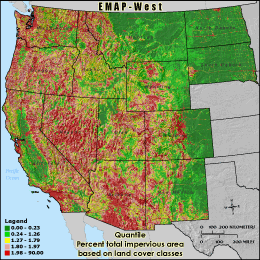Methodology and Interpretation
PCTIA_LC - Percent total impervious area based on land cover classes
The percent total impervious area is calculated by multiplying an
imperviousness factor by the the proportion of certain land cover types
known to be partially impervious. Default impervious factors are based
on literature (Caraco et al. 1998), but may be changed by the user.
Caraco, D., Claytor, R., Hinkel,P., Kwon, H.Y., Schueler, T., Swann, C.,
Vysotsky, S. and Zielinske, J. 1998. Rapid Watershed Planning Handbook.
Center for Watershed Protection. Ellicott City, Maryland.


Quantile: Each class contains an approximately equal number (count) of features. A quantile
classification is well-suited to linearly distributed data. Because features are grouped by the number
within each class, the resulting map can be misleading, in that similar features can be separated into
adjacent classes, or features with widely different values can be lumped into the same class. This
distortion can be minimized by increasing the number of classes.
Natural Breaks: Classes are based on natural groupings of data values. Natural break points
are identified by looking for groupings and patterns inherent in the data. The features are divided
into classes whose boundaries are set where there are relatively large jumps in the distribution of
data values.
* EMAP-West Landscape Metrics Metadata (FGDC)
|

